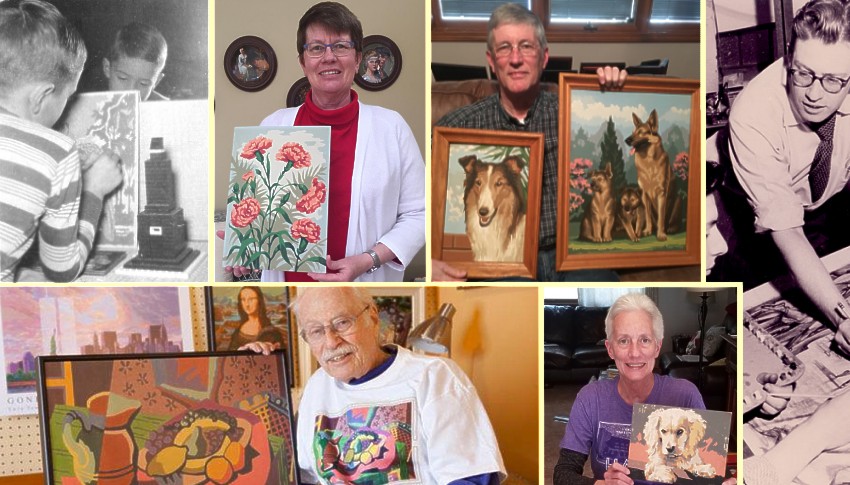Kansas Snapshots by Gloria Freeland - April 19, 2019
Staying inside the lines
When I was in grade school, our teachers would often pass out sheets with outlines of countries, animals, flowers or other objects.
Our assignment was to color the pages, using our big boxes of colored pencils or Crayons. She would start us on our task with the
admonishment, “Stay inside the lines.” And so we did our best.
I enjoyed doing them as a break from whatever lesson we were learning, but I never considered our activity to be particularly artistic.
But for some reason, a paint-by-number picture I did as a child elicited a creative spark in me. It was of a cocker spaniel and it
reminded me of our own farm dog Dusty. I hadn’t thought of that in years, but was reminded of it recently when I learned that Dan
Robbins, the inventor of paint-by-numbers, died at 93 earlier this month.
For those unfamiliar with this craze that swept the country in the 1950s, a paint-by-number picture is much like those outlines we
were given in school. The difference is each area contained a number and that number corresponded to the color of paint to be used
to fill in that space.
Robbins, fresh from the Army after World War II where he had honed his artistic skills designing maps, was working as a package
designer at Palmer Paint Company. Max Klein, the company’s owner, asked Robbins to find a way to market the
paint to adults. Robbins came up with the paint-by-number idea when he remembered something he learned in high school - that
Leonardo da Vinci used a numbering system for his own students. It seems that when this ultimate “Renaissance man” had his students
paint the backgrounds or less important parts of a picture before the master completed the main portions, he would tell them what
colors he wanted them to use by employing a numbering scheme.
The Palmer Company began to produce paint-by-number kits under the name Craft Master. Beginner kits usually had only 20 colors, while
intermediate kits had 30 or 40. Because leisure time was at an all-time high after the war, some 20 million paint-by-number kits sold
in 1955 alone.
That was the year my brother Dave, then 7, painted a pair of birds. He apparently caught the paint-by-number “bug” because he
eventually did horses, dogs, flowers and other pictures. He gave a pair of his flower pictures to sister Gaila and me a
few years back. I have the roses and Gaila has the carnations, both of which he painted for our Grandma Ethel Freeland.
Scrawled on the back of the paintings in Dave’s 13-year-old handwriting was: “Happy Birthday 1960. To Grandma. From David, Gloria and
Gaila. Made by David.”
I asked Dave how he began.
I’m not sure how I got started. Maybe I saw some of Mom’s artwork, but I knew I couldn’t draw, so easy paint-by-numbers was the next
best thing! I really enjoyed it - kind of a stress reliever you could say. Each set got a little bit more intricate, too. Kind of
amazing I still have all of them. Too bad kids of today know nothing about this "lost art!”
Gaila enjoyed them, too.
“... I loved doing them. The little paint wells, paintbrush and template. Not very creative on our part, since it was pretty much
spelled out for us what to do, but it kept us occupied.”
Although art critics at the time were appalled, ordinary people couldn’t seem to get enough of the kits. People wanted kittens,
puppies, horses and landscapes. The Last Supper was one of the company’s most-popular sets.
According to an April 5 National Public Radio report, the Craft Master paint-by-number kits didn’t save the Palmer Company, which
faced bankruptcy at the height of their popularity. Some 30 other companies were producing kits at the same time. But Robbins kept
making his own art and freelancing for commercial clients. One of his later jobs was designing Happy Meals for McDonald’s.
In 2001, the Smithsonian Institution’s National Museum of American History had an exhibition, “Paint by Number: Accounting for Taste
in the 1950s,” curated by William Bird.
In the recent NPR report, Bird, now curator emeritus, said Robbins “democratized access to the apparatus of art for people who would
never have been exposed to them otherwise. He put brushes into the hands of people.” Robbins’ son Larry said his father didn’t seem
to be bothered by critics who dismissed paint-by-numbers. He said his father took pride in giving people who might not otherwise
have the opportunity “the experience of what it was like to paint,” regardless of their ability.
Today, hobbyists can still find paint-by-number kits in local craft stores. Those who want something a bit more personal can even
have their own photographs converted into paint-by-numbers.
Across the country, those 1950s-era paint-by-numbers can fetch pretty good prices in flea markets and collectibles shops.
So what became of my cocker spaniel and the puppy Gaila made and Dave’s multiple paintings? After I heard about Robbins’ death, I
searched for my lone paint-by-number work and found it in a trunk. Gaila said she couldn’t find hers. Dave kept all his - save for
the flowers he gave to Gaila and me.
The roses Dave gave me are mounted in a dark-green frame and have a place of honor in our dining room under one of Mom’s original
paintings.
Both make me smile - and what more could one ask of artwork, whether the artist stayed inside the lines or not.
